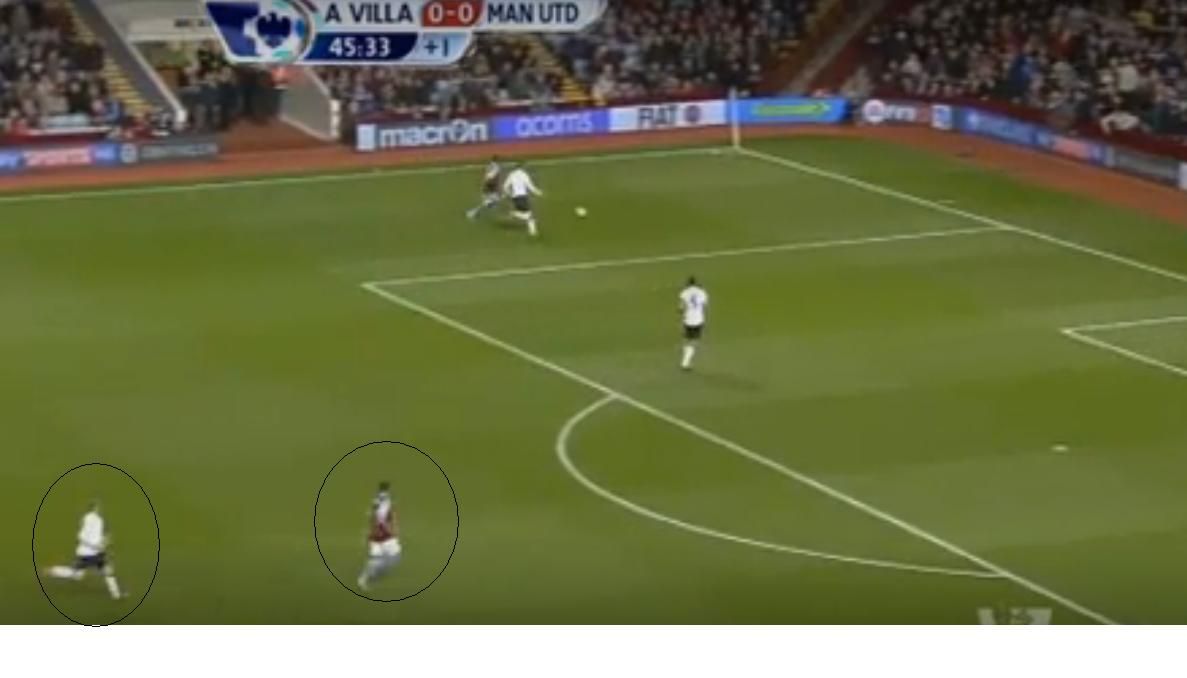
Frame-by-frame analysis: How Man United made the same mistake twice
Like the Little Pea said after the match, “In the end, the three points are all that matter.” That’s true. If Man United win the title in May, nobody will remember how they conceded the two goals against Aston Villa. The scoreline will be, though, because Aston Villa were on the receiving end yet again. The next time these two meet, Villa might as well start the game at 2-0, so that we get to see this panic-inducing and exhilarating United for the full 90 minutes, and not just 45.
But to simply ignore the goals conceded as merely a catalyst that spurred Man United on, would be wrong. No, not because of the title lost on goal difference last season. That has happened once in the history of the Premier League.
The thing to concentrate on is the way those goals were conceded. Both are very similar in the sense that Man United made the same mistake twice.
(Apologies for the poor quality of the screen-grabs).
Villa’s first goal
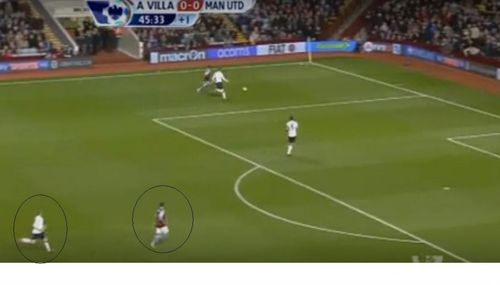
As Benteke (top) takes the ball down the line, Smalling follows him and Ferdinand maintains his position in the box, ready to clear the danger in case Benteke cuts inside. Rooney (bottom left) tries to get closer to the Villa player making a run into the box. 3 defenders vs 2 attackers. So far, so good.
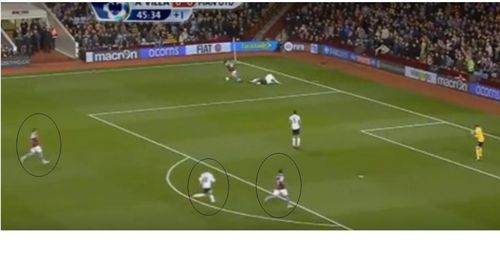
Benteke loses his man. Smalling is down (injured/lost balance). Ferdinand is there to provide cover. But a late run from a Villa player (Weimann, left) has altered the equation. Assuming Smalling can’t be involved any further in the play, it’s now 3 Villa attackers versus 2 defenders (Rooney and Ferdinand). That’s never good. Rooney has now moved closer to his man.
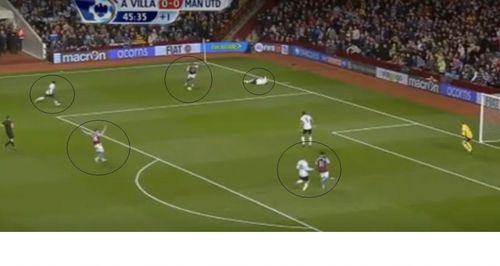
Rooney is quite rightly drawn to the Villa player in the box. He is now in a position to man-mark the Villa striker, incase of a direct cross from Benteke. Evra (top left) rushes in to block Benteke’s path to goal and maintain parity in terms of attackers and defenders. 3 vs 3. Notice the absence of any Man United midfielders on the edge of the box. The Villa player (Weimann, left) is on the edge of the box, arms outstretched asking for a pass.
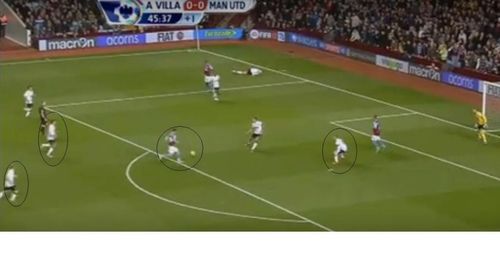
By the time Evra reaches Benteke, the pass is already on its way to a free-as-a-bird Weimann on the edge of the box. Carrick and Scholes (bottom left) have just entered the play, and are too far away to close Weimann down. No cover in front of the defenders. It wasn’t the quickest of breaks from Villa, but quick enough for a recovering United midfield. Weimann hits it first time. 1-0 Villa.
Villa’s second goal
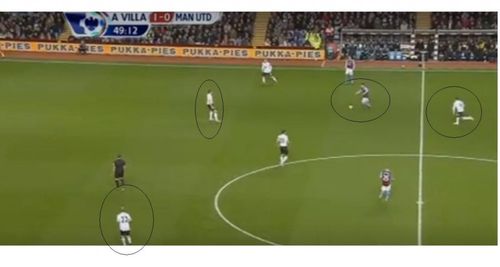
The Villa midfielder has the ball on the halfway line. Carrick (top left) and Scholes (bottom left) seem to have all his passing options covered. No imminent danger. Chicharito (right) is rushing in to put pressure on the man with the ball.
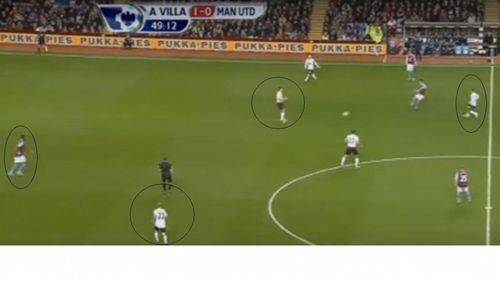
One of the Villa forwards (Benteke, left) has dropped deep to collect the ball. The pass is sent to him, completely bypassing the United midfield in one go. Scholes is ambling across to the vacant space in the middle.

Scholes is drawn to Benteke (center, with ball). One of the United centrebacks (Ferdinand) follows Benteke to not allow him from turning with the ball. Ireland (bottom left) is free for a pass.
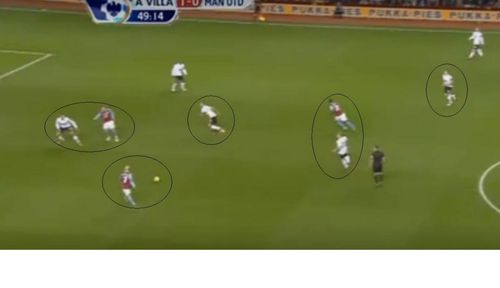
Benteke’s dummy is the gamechanger here. Carrick (top right) is out of play. Scholes has closed in on Benteke, but the ball has already moved on to Ireland. Ferdinand (center) rushes to get back into position. Smalling is marking Weimann, the furthest Villa player.
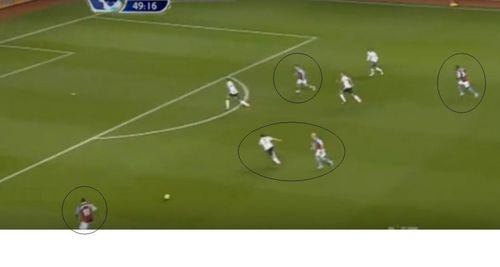
Ireland sends the ball wide to Agbonlahor (bottom left). Rafael closes down Ireland but the ball is already gone. Agbonlahor is free on the left, about to receive the ball just outside the Man United box.
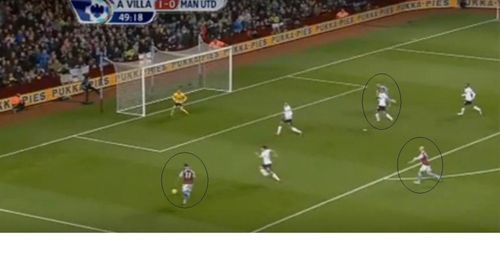
Agbonlahor uses his extra pace to get into the box instantly. Since the right zone is Rafael’s, he leaves Ireland and rushes to block Agbonlahor’s pass. Ireland is free on the edge of the box, pleading for a cut-back with arms wide open.
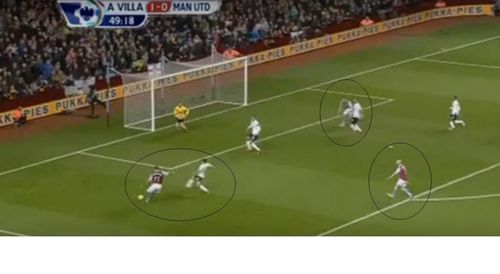
Rafael’s block is too late as Agbonlahor gears up to send across a quick, low pass. Ireland is still free on the edge of the box. Neither of Carrick and Scholes have gotten near him.
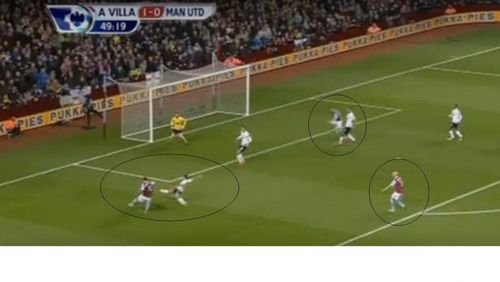
Smalling is covering the near side of the goal, Ferdinand has Weimann behind him. Weimann times his run, buries the pass from Agbonlahor and its 2-0 to Villa. This time the goal came from a different position, but the empty space in front of the United box is the only constant as far as the two goals are concerned. If Agbonlahor would have cut it back to Ireland, it would have been a mirror-image of the lead-up to the first goal.
Plausible conclusion: Carrick, and Scholes especially, take time to come back to their (usual) deeper midfield positions after a United attack has broken down. Although their presence allows Manchester United the lion’s share of the possession, the opposition is likely to score through quick transitions, since they don’t expect to have the ball at all times.
One of Cleverley or Anderson must start if United are to use a 4-4-1-1. Since the emphasis is on a two-man midfield with Rooney playing as an auxiliary forward, both central midfielders cannot be passers. You need a runner, someone like Cleverley or Anderson, in the middle to stop or at least minimize the chances of attacks like these turning into goals.